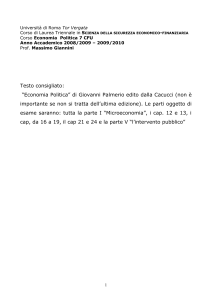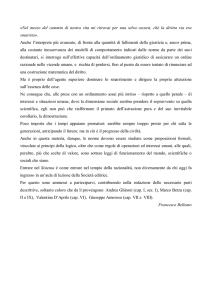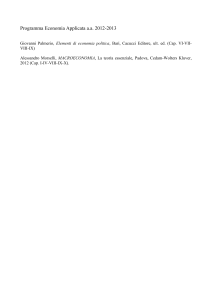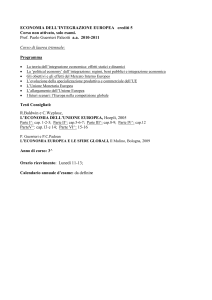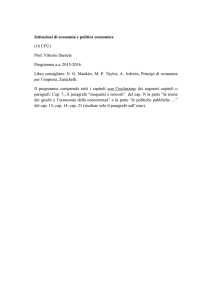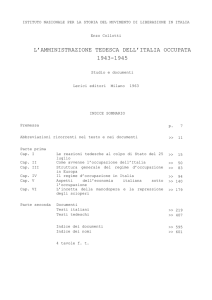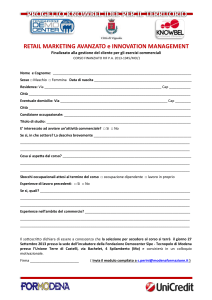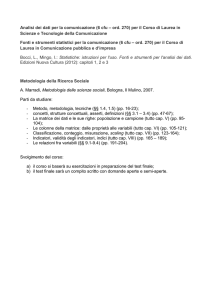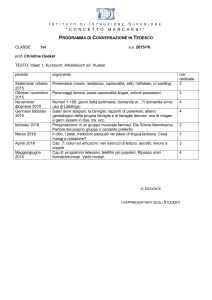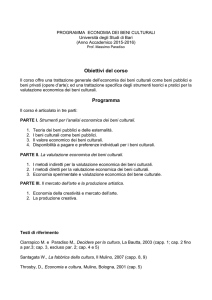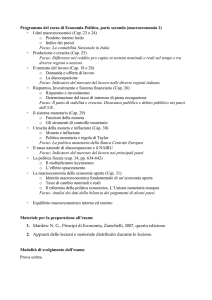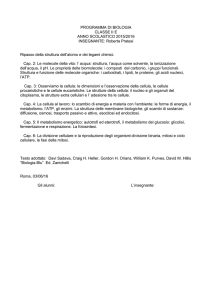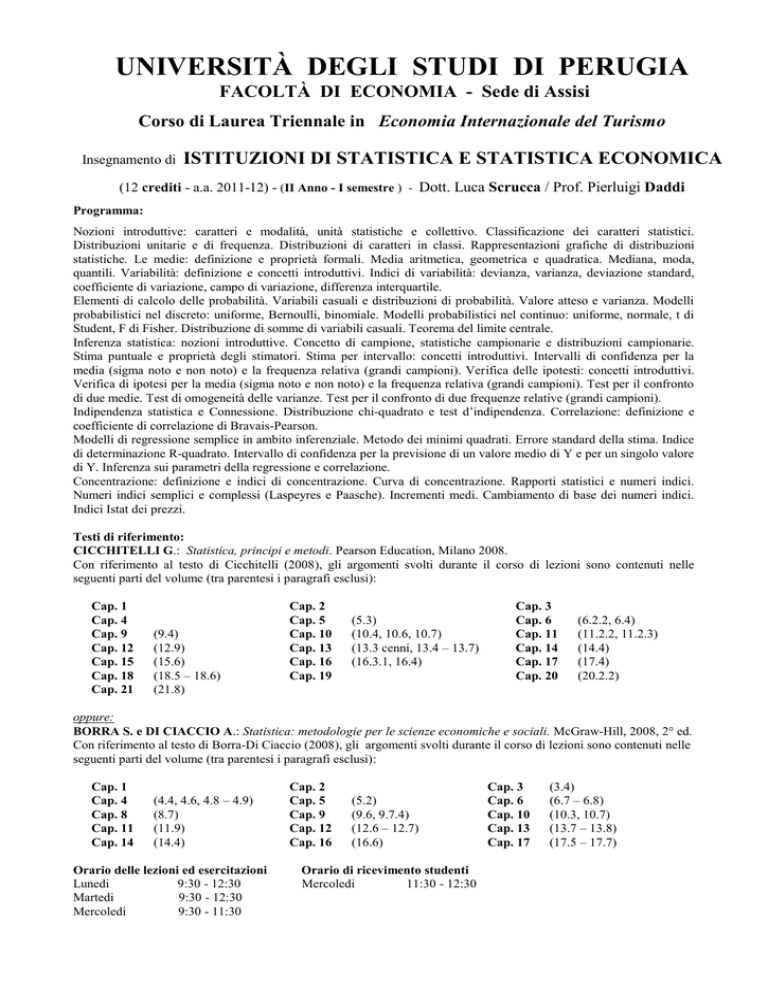
UNIVERSITÀ DEGLI STUDI DI PERUGIA
FACOLTÀ DI ECONOMIA - Sede di Assisi
Corso di Laurea Triennale in Economia Internazionale del Turismo
Insegnamento di
ISTITUZIONI DI STATISTICA E STATISTICA ECONOMICA
(12 crediti - a.a. 2011-12) - (II Anno - I semestre ) - Dott. Luca Scrucca / Prof. Pierluigi Daddi
Programma:
Nozioni introduttive: caratteri e modalità, unità statistiche e collettivo. Classificazione dei caratteri statistici.
Distribuzioni unitarie e di frequenza. Distribuzioni di caratteri in classi. Rappresentazioni grafiche di distribuzioni
statistiche. Le medie: definizione e proprietà formali. Media aritmetica, geometrica e quadratica. Mediana, moda,
quantili. Variabilità: definizione e concetti introduttivi. Indici di variabilità: devianza, varianza, deviazione standard,
coefficiente di variazione, campo di variazione, differenza interquartile.
Elementi di calcolo delle probabilità. Variabili casuali e distribuzioni di probabilità. Valore atteso e varianza. Modelli
probabilistici nel discreto: uniforme, Bernoulli, binomiale. Modelli probabilistici nel continuo: uniforme, normale, t di
Student, F di Fisher. Distribuzione di somme di variabili casuali. Teorema del limite centrale.
Inferenza statistica: nozioni introduttive. Concetto di campione, statistiche campionarie e distribuzioni campionarie.
Stima puntuale e proprietà degli stimatori. Stima per intervallo: concetti introduttivi. Intervalli di confidenza per la
media (sigma noto e non noto) e la frequenza relativa (grandi campioni). Verifica delle ipotesti: concetti introduttivi.
Verifica di ipotesi per la media (sigma noto e non noto) e la frequenza relativa (grandi campioni). Test per il confronto
di due medie. Test di omogeneità delle varianze. Test per il confronto di due frequenze relative (grandi campioni).
Indipendenza statistica e Connessione. Distribuzione chi-quadrato e test d’indipendenza. Correlazione: definizione e
coefficiente di correlazione di Bravais-Pearson.
Modelli di regressione semplice in ambito inferenziale. Metodo dei minimi quadrati. Errore standard della stima. Indice
di determinazione R-quadrato. Intervallo di confidenza per la previsione di un valore medio di Y e per un singolo valore
di Y. Inferenza sui parametri della regressione e correlazione.
Concentrazione: definizione e indici di concentrazione. Curva di concentrazione. Rapporti statistici e numeri indici.
Numeri indici semplici e complessi (Laspeyres e Paasche). Incrementi medi. Cambiamento di base dei numeri indici.
Indici Istat dei prezzi.
Testi di riferimento:
CICCHITELLI G.: Statistica, principi e metodi. Pearson Education, Milano 2008.
Con riferimento al testo di Cicchitelli (2008), gli argomenti svolti durante il corso di lezioni sono contenuti nelle
seguenti parti del volume (tra parentesi i paragrafi esclusi):
Cap. 1
Cap. 4
Cap. 9
Cap. 12
Cap. 15
Cap. 18
Cap. 21
(9.4)
(12.9)
(15.6)
(18.5 – 18.6)
(21.8)
Cap. 2
Cap. 5
Cap. 10
Cap. 13
Cap. 16
Cap. 19
(5.3)
(10.4, 10.6, 10.7)
(13.3 cenni, 13.4 – 13.7)
(16.3.1, 16.4)
Cap. 3
Cap. 6
Cap. 11
Cap. 14
Cap. 17
Cap. 20
(6.2.2, 6.4)
(11.2.2, 11.2.3)
(14.4)
(17.4)
(20.2.2)
oppure:
BORRA S. e DI CIACCIO A.: Statistica: metodologie per le scienze economiche e sociali. McGraw-Hill, 2008, 2° ed.
Con riferimento al testo di Borra-Di Ciaccio (2008), gli argomenti svolti durante il corso di lezioni sono contenuti nelle
seguenti parti del volume (tra parentesi i paragrafi esclusi):
Cap. 1
Cap. 4
Cap. 8
Cap. 11
Cap. 14
(4.4, 4.6, 4.8 – 4.9)
(8.7)
(11.9)
(14.4)
Orario delle lezioni ed esercitazioni
Lunedi
9:30 - 12:30
Martedi
9:30 - 12:30
Mercoledi
9:30 - 11:30
Cap. 2
Cap. 5
Cap. 9
Cap. 12
Cap. 16
(5.2)
(9.6, 9.7.4)
(12.6 – 12.7)
(16.6)
Orario di ricevimento studenti
Mercoledi
11:30 - 12:30
Cap. 3
Cap. 6
Cap. 10
Cap. 13
Cap. 17
(3.4)
(6.7 – 6.8)
(10.3, 10.7)
(13.7 – 13.8)
(17.5 – 17.7)
PERUGIA UNIVERSITY
Faculty of Economics
Degree Course in International Economics for Tourism
Assisi
Course
Statistics and Economic Statistics
(First Course, 6 Cfu, 2011-12)
(II Year of studies - I semester - Course taught in Italian - Dr. Luca Scrucca, Prof. Pierluigi Daddi)
Course Content Summary:
Introduction: statistical variables, statistical units and population. Classification of statistical variables. Unitary
distributions and frequency distributions. Distributions of variables in classes. Graphical representation of statistical
distributions. Means: definition and formal properties. Arithmetic, geometric and quadratic mean. Median, mode,
quantiles. Variability: definition and basic concepts. Indices of variability: deviation, variance, standard deviation,
coefficient of variation, range, interquartile range.
Elements of probability. Random variables and probability distributions. Expected value and variance. Probabilistic
models for discrete random variables: uniform, Bernoulli, binomial. Probabilistic models for continuous random
variables: uniform, normal, Student t, Fisher F. Distribution of sums of random variables. Central Limit Theorem.
Statistical inference: introduction. Concepts of sample, sample statistics and sampling distributions. Point estimation and
properties of estimators. Interval estimation: basic concepts. Confidence intervals for the mean (sigma known and
unknown) and the proportion (large samples). Hypothesis testing: introductory concepts. Hypothesis testing for the mean
(sigma known and unknown) and for the proportion (large samples). Hypothesis testing for comparing two means. Test
of homogeneity of variances. Hypothesis testing for comparing two proportions (large samples).
Statistical independence. Chi-square tests of independence. Correlation: definition and correlation coefficient of
Bravais-Pearson.
Simple regression models in the inferential framework. Method of least squares. Standard error of the estimates. Index
of determination R-squared. Confidence intervals for the prediction of an average value of Y and a single value of Y.
Inference on the parameters of the regression and correlation.
Concentration: definition and concentration indices. Concentration curve. Ratios and statistical index numbers. Simple
and complex index numbers (Laspeyres and Paasche). Average increases. Changing the basis of index numbers. Istat
indices of prices.
Testi di riferimento:
CICCHITELLI G.: Statistica, principi e metodi. Pearson Education, Milano 2008.
With reference to the book of Cicchitelli (2008), the arguments covered in class are contained in the following parts of
the book (excluding the paragraphs in brackets):
Ch. 1
Ch. 4
Ch. 9
Ch. 12
Ch. 15
Ch. 18
Ch. 21
(9.4)
(12.9)
(15.6)
(18.5 – 18.6)
(21.8)
Ch. 2
Ch. 5
Ch. 10
Ch. 13
Ch. 16
Ch. 19
Ch. 3
Ch. 6
Ch. 11
Ch. 14
Ch. 17
Ch. 20
(5.3)
(10.4, 10.6, 10.7)
(13.3 read, 13.4 – 13.7)
(16.3.1, 16.4)
(6.2.2, 6.4)
(11.2.2, 11.2.3)
(14.4)
(17.4)
(20.2.2)
oppure:
BORRA S. e DI CIACCIO A.: Statistica: metodologie per le scienze economiche e sociali. McGraw-Hill, 2008, 2° ed.
With reference to the book of Borra-Di Ciaccio (2008), the arguments covered in class are contained in the following
parts of the book (excluding the paragraphs in brackets):
Ch. 1
Ch. 4
Ch. 8
Ch. 11
Ch. 14
(4.4, 4.6, 4.8 – 4.9)
(8.7)
(11.9)
(14.4)
Ch. 2
Ch. 5
Ch. 9
Ch. 12
Ch. 16
Schedule of lectures and exercise sessions
(5.2)
(9.6, 9.7.4)
(12.6 – 12.7)
(16.6)
Ch. 3
Ch. 6
Ch. 10
Ch. 13
Ch. 17
Office hours for students
(3.4)
(6.7 – 6.8)
(10.3, 10.7)
(13.7 – 13.8)
(17.5 – 17.7)
Monday
Tuesday
Wednesday
9:30 - 12:30
9:30 - 12:30
9:30 - 11:30
Wednesday
11:30 - 12:30

